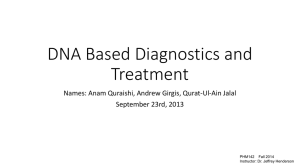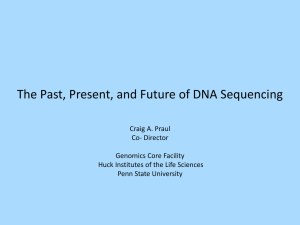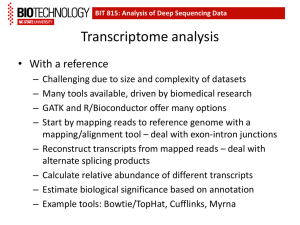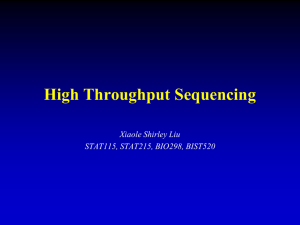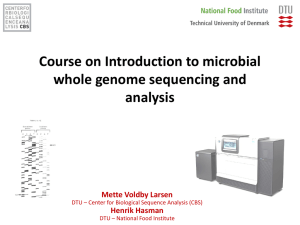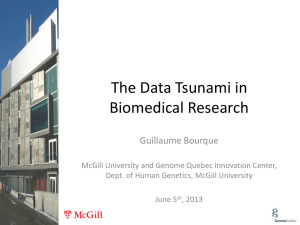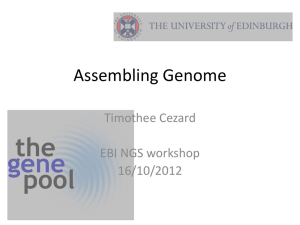ppt - IRMACS Centre
advertisement
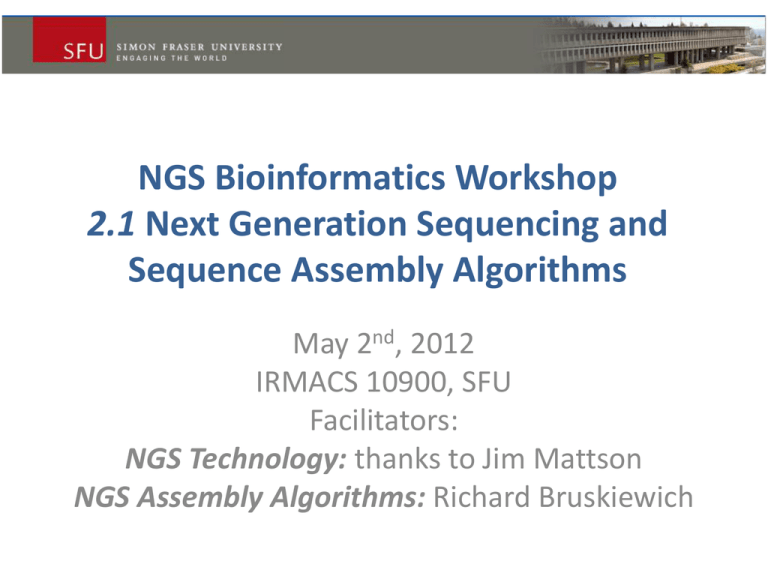
NGS Bioinformatics Workshop 2.1 Next Generation Sequencing and Sequence Assembly Algorithms May 2nd, 2012 IRMACS 10900, SFU Facilitators: NGS Technology: thanks to Jim Mattson NGS Assembly Algorithms: Richard Bruskiewich NGS Bioinformatics – 2nd Part Topic Lecture (12:30 – 14:30, Wednesdays) Demo/Lab (9:30 – 11:30, Thursdays) Next Generation Sequence Analysis and Beyond Next Generation Sequencing and Sequence Assembly Algorithms May 2nd May 3rd Sequence Assembly of Whole Genomes May 9th May 10th Sequence Assembly of Transcriptomes May 16th May 17th Identification and Analysis of Sequence Variation May 23rd May 24th Comparative Genomic Analysis and Visualization May 30th May 31st Meta-Analysis of Genomic Data June 6th June 7th Overview Sequencing: Sanger method (brief review) “Next Generation” Sequencing (NGS) In depth treatment by Jim Mattson… Overview of sequence assembly What is a “Sequence Read”? A single instance of experimentally obtained subsequence representing a (possibly erroneous, likely biased) subsampling of a sequence space of (generally larger) target nucleotide molecules, which may also have some computed associated measure of quality 2.1 Next Generation Sequencing and Sequence Assembly Algorithms SANGER SEQUENCING Contigs and Sanger Automated Sequencing Chromosome Large-insert Clones Large insert library Sequencing reads from subclones Shotgun cloning Sequence reads Sequencing C A G A C T A C C G T T A G A C T T Dideoxy chain-termination (“Sanger”) Method NGS Trend PubMed was “searched in two-year increments for key words and the number of hits plotted over time.” From the following article What would you do if you could sequence everything? Avak Kahvejian, John Quackenbush & John F Thompson Nature Biotechnology 26, 1125 - 1133 (2008) doi:10.1038/nbt1494 “Next generation” or “Deep” sequencing Example: Illumina Genome Analyzer II sequencing Rapid, short-read sequencing Less accurate but higher coverage compensates Benefits greatly from Paired-End sequencing (Mate pairs) Sequence two ends of a fragment of known size. Fragment length (insert size) can range from 2 – 5 kb Illumina reads can range from 25-77 bps (longer length better except for high GC sequence - most use 100 or 150 bp reads now) ~200 million reads What is a Mate-Pair (or Long Paired-End) library? Mate-pair library is the Illumina synonym for the Roche long paired-end library (LPE). While the long paired end library is adapted to be sequenced on GS FLX, the mate-pair library is adapted to the Illumina HiSeq 2000 technology. The library consists of approximately 150-300 bp fragments. These are composed of 2 DNA segments originally located 2-5 kbp apart in the genome of interest. With a mate-pair library it is therefore possible to span gaps or repeats of up to 2-5 kbp. Paired End Reads are Important! Known Distance Read 1 Read 2 Repetitive DNA Unique DNA Paired read maps uniquely Single read maps to multiple positions 2.1 Next Generation Sequencing and Sequence Assembly Algorithms NGS SEQUENCING TECHNOLOGIES Over to Jim Mattson 1.5 Principles of Genomics, Next Generation Sequencing and Sequence Assembly Algorithms SEQUENCE ASSEMBLY What is a sequence assembly? An assembly is an hierarchical data structure that maps the sequence data to a putative reconstruction of the target* (*) Miller JR, Koren S and Sutton G. 2010. Assembly algorithms for nextgeneration sequencing data. Genomics 95:315-327 (Classical, Sanger) Sequence Assembly Early genomes were sequenced on the basis of decomposition of genomes and chromosomes into tractable sizes of (subcloned) DNA (~100 kb), ordered and oriented by detailed genetic and physical maps. Clone-by-clone based sequence assembly was a simpler computational problem given the relatively small size and reduced complexity of the sequence target (subclone) and relatively long Sanger reads, but was extremely costly due to the experimental overhead of the DNA decomposition. “Classical” Sequence Assembly Read, edit & trim DNA chromatograms Remove overlaps & ambiguous calls Read in all sequence files (10-10,000) Reverse complement all sequences (doubles # of sequences to align) Remove vector sequences (vector trim) Remove regions of low complexity Perform multiple sequence alignment & merge Fill (“finish”) gaps using a variety of experimental procedures. Contig Alignment - Process ATCGATGCGTAGCAGACTACCGTTACGATGCCTT… Sanger Automated Sequence Assembly Software Phred: base calling program that does detailed statistical analysis on Sanger chromatogram (“trace”) files Concept of “PHRED” quality score for base pairs Q = -10 log10( Pe ) e.g. 1 error in 1000 = -10 log10 (10-3) = 30 Phrap: sequence assembly program http://www.phrap.org/phredphrapconsed.html Ewing et al. Genome Research 1998, Vol. 8, Issue 3 for a good overview. Whole Genome Shot-Gun Sequencing Takes reads from random positions along a target molecule Whole-genome shotgun (WGS) sequencing samples all of the chromosomes that make up one genome. What is a WGS sequence assembly? WGS assembly is the reconstruction of sequence up to chromosome length, through over-sampling such that reads overlap. Groups reads into contigs, and contigs into scaffolds Contigs document a multiple sequence alignment of reads into a contiguous consensus Scaffolds are gapped sequences composed of ordered and oriented contigs with inferred gaps indicated as indeterminate bases (N’s) Confounding factors for NGS WGS assembly Assembly of NGS reads is generally limited by the fact that read lengths are much shorter than even the smallest genome. Random oversampling of the target tries to overcome this limitation however… All current NGS technologies are intrinsically error prone hence imperfect alignments are tolerated in assembly algorithms, but… Target genomes are generally full of subtly divergent repetitive content of diverse nature, generally of a length longer than NGS read lengths, it is not easy to always know what is sequencing error versus a sequence variant Opportunity cost of sequencing errors… Software must tolerate imperfect sequence alignments to avoid missing true joins, however, this error tolerance may introduce false-positive joins of reads that induce chimeric assemblies Opportunity cost of sequencing errors In practice, tolerance for sequencing error makes it difficult to resolve a wide range of genomic variation: Polymorphic repeats Polymorphic differences between non-clonal asexual individuals Polymorphic differences between non-inbred sexual individuals Polymorphic haplotypes from one non-inbred individual Other Limitations in Assemblies Assembly is also confounded by non-uniform coverage of the target Cellular copy number variation in source molecules. Remember too that this kind of variation may have intrinsic scientific interest: e.g. estimation of gene expression via NGS transcriptome assembly (RNA-Seq) Compositional biases of sequencing technology (e.g. paucity of representation of AT rich and/or GC rich fragments in NGS templates) NGS Contig & Scaffold Assembly Strive for proper experimental design for libraries (e.g. sample quality, mate pair insert sizes, etc.) Transfer raw read data into analysis environment (it may be a non-trivial task to load the enormous raw read files into the computer for the analysis) Perform bulk statistical analysis of raw read data to ascertain overall dataset quality Filter out and trim reads based on low quality thresholds Select a k-mer size Perform assembly based on selected k-mer size (and perhaps, mate pair library insert size). Measure quality of assembly. Iterate on other k-mer sizes to improve quality. Use multiple assembly programs and compare results. Measuring the quality of an assembly The most common (and crude) metric of assembly “quality” is N50, which is a weighted median of lengths of items equal to the length of the longest item i such that the sum of the lengths of items greater than or equal in length to i is greater than or equal to half of the length of all of the items. The items in question are generally specified: either the contigs or scaffolds of the assembly. A number of additional metrics have now been developed by the bioinformatics community*. (*) Earl DA et al. 2011 Assemblathon 1: A competitive assessment of de novo short read assembly methods. http://genome.cshlp.org/content/early/2011/09/16/gr.126599.111 Two Classes of Assembly Map-based WGS assembly refers to reconstruction of the underlying sequence facilitated by alignments to a previously resolved reference sequences. de novo WGS assembly refers to reconstruction of the underlying sequence without a previously resolved reference sequence. Map-Based Assembly Map alignment assembly of short reads Strategy: index the reference genome sequence and search it efficiently For this purpose, map-alignment sequence assembly approaches generally use a computing strategy called Burrows– Wheeler indexing to notablyreduce compute time and memory usage, see http://bio-bwa.sourceforge.net MAQ – Mapping and Assembly with Quality Heng Li, Sanger Centre http://maq.sourceforge.net/maq-man.shtml Bowtie - An ultrafast memory-efficient short read aligner Ben Langmead and Cole Trapnell, University of Maryland http://bowtie-bio.sourceforge.net/ SOAPAligner from SOAP (Short Oligonucleotide Analysis Package) http://soap.genomics.org.cn/soapaligner.html de novo Assemblies Graph Theory The mathematical concept(*) of a graph is a topographical data abstraction which is a set of nodes (vertices) are connected by a set of edges (arcs). Nodes are some object in a collection and edges are their relationships This is a widely used data structure in computing science, used to represent many diverse computational problems (and used in many computing algorithms) (*) First defined by the great mathematician Leonhard Euler in 1735, as a tool to solve the 'Bridges of Königsberg problem’. See http://en.wikipedia.org/wiki/Graph_theory What is a k-mer? For efficiency, all NGS assembly software relies to some extent on the notion of a k-mer. A k-mer is a contiguous sequence of k base calls, where k is any positive integer. Intuitively, sequence reads with high similarity must share k-mers in their overlapping regions Fast detection (by indexing) of shared k-mer content is computationally far less expensive than “all-against-all” sequence alignment detection of variable length sequence overlaps. de Bruijn Graphs of k-mer de Bruijn graphs were developed outside of the field of sequence assembly as a data representation for arbitrary strings spanning a finite alphabet. The nodes of a de Bruijn graph represent all possible fixed length strings. The edges represent suffix-to-prefix perfect overlaps. Graphs of all k-mers and their fixed length overlaps observed in a target nucleotide sequence (or a sequence sampling of that target), is a kind of de Bruijn graph The primary advantage of de Bruijn graphs is that their size is generally delimited by the complexity of the underlying genome, not by the total number (“depth”) of reads The primary disadvantage is that different sequences (i.e. reads) can theoretically resolve to identical de Bruijn graphs due to internal repeat content (cycles in the graph) See: Compeau PEC, Pevzner PA and Tesler G. 2011. How to apply de Bruijn graphs to genome assembly. Nature Biotechnology 29, 987–991. doi:10.1038/nbt.2023 Example of a DNA Sequence de Bruijn Graph From http://www.homolog.us/blogs/2011/07/28/de-bruijn-graphs-i/ accessed 30/4/2012 Sequencing Errors Generate Lightly Travelled Divergent Paths in de Bruijn graphs Sequence assembly algorithms can prune such lightly travelled paths but reconstruct the genome from heavily traversed paths. Repeat Content in Targets Add Graph Cycles Spanning or Mate-Pair Reads Resolve Complexity The Computational Challenge of Assembly Sequencing generates enormous data sets with highly heterogeneous sequence reads. This is especially true of NGS. This adds complexity to computation: graph processing algorithms are in the category of NP complete computing problems (=> really hard!) hence rely heavily on heuristics to solve (but still demand a significant number of CPU cycles) de Bruijn graphs constructed to merge read data are inherently very large – due to the observed number of distinct k-mers in the target sequences - hence require significant computer memory to hold the constructed graph De novo NGS WGS assembly of short reads Velvet Daniel Zerbino and Ewan Birney, EMBL-EBI http://www.ebi.ac.uk/~zerbino/velvet/ ABySS Inanç Birol, Shaun Jackman, Steve Jones and others, GSC http://www.bcgsc.ca/platform/bioinfo/software/abyss ALLPATHS-LG Jaffe et al CRD, Broad Institute http://www.broadinstitute.org/software/allpaths-lg/blog/ SOAPdenovo Li et al. Beijing Genome Institute http://soap.genomics.org.cn/soapdenovo.html Additional software listed in the Earl DA et al. 2011. Assemblathon 1: A competitive assessment of de novo short read assembly methods. http://genome.cshlp.org/content/early/2011/09/16/gr.126599.111 Transcriptome Assembly has Additional Considerations Transcripts from highly similar paralogous loci is another instance of the repetitive sequence problem Alternate splicing also generates branching de Bruijn graphs Catch-22: Assembly efficacy biased by gene expression variation in the numbers of raw reads (i.e. especially for transcripts with low gene expression). Gene expression estimates from NGS sequencing (“RNA-Seq”) confounded by NGS sequence technology compositional biases and the above graph resolution issues Detection of Sequence Variants is a Challenge Sequencing errors can masquerade as variation Gene copy number polymorphism, segmental duplication, resolution of linkage haplotypes, etc. are special cases of the repeat duplication problem

